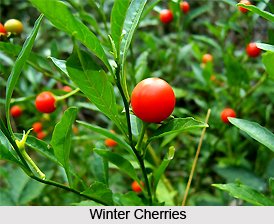 Winter cherry is a small or medium-sized, upright shrub, growing upto 1.5 metres in height. Its stems and branches are covered with minute star-shaped hairs. It has egg-shaped, hairy leaves upto 10 cm in length, tiny, pale green flowers in bunches of nearly 25; and polished, globular, red fruits with yellow seeds. Its trade name `ashvagandha` is based on its Indian name.
Winter cherry is a small or medium-sized, upright shrub, growing upto 1.5 metres in height. Its stems and branches are covered with minute star-shaped hairs. It has egg-shaped, hairy leaves upto 10 cm in length, tiny, pale green flowers in bunches of nearly 25; and polished, globular, red fruits with yellow seeds. Its trade name `ashvagandha` is based on its Indian name.
Winter cherry is native to India. It is also available in Afghanistan, Pakistan and Sri Lanka.
The herb contains an alkaloid somniferine. Its roots contain traces of a volatile oil. The water-soluble portion of root extract contains indistinct amorphous substances and an amount of sugar. The water-soluble extract consists mainly of a black resin, which contains besides other factors, an assortment of some fatty acids. It also consists of potassium nitrate, tannin, colouring matter, glucose and some alkaloids.
Methods of usage
Winter cherry comes to use in various chronic disorders, like digestive disorder, exhaustion, rheumatism, tuberculosis, insomnia, gynaecological troubles or cold.
Healing Power and Medicinal Properties of winter cherry
The whole herb is used for several medicinal applications for its hypnotic and tranquillising properties. It encourages libido. The root of the plant is a revitaliser and stimulant. It increases secretion and disposal of urine and also other forms of secretion or excretion by opening the natural pores of the body. Latest experiments have proved that its roots and leaves possess antibiotic and antibacterial properties.
Digestive Disorders cured by winter cherry
The root of the plant is used for healing digestive disorders like dyspepsia and loss of appetite. It disciplines the perturbed processes of nutrition and reinstates normality in the system.
General Debility cured by winter cherry
The roots come to immense use in treating general debility. It is taken in 2-gram dosages for this purpose.
Rheumatism healed by winter cherry
The root is efficacious for treating rheumatic troubles. It should be had in 3-gram dosages for treating this condition.
Tuberculosis healed by winter cherry
The root finds its efficiency for treating tuberculosis. A decoction of the root is used together with long pepper and honey. This decoction is also advantageous in the treatment of scrofula, i.e., tuberculosis of lymph glands, particularly in the neck.
Insomnia cured by winter cherry
The root also acts as a sedative, bringing in deep sleep and hence favourable in treating insomnia.
Cold and Cough cured by winter cherry
Winter cherry is advantageous in the treatment of chest diseases like cough and cold. The root can be consumed either in the form of pulverisation in 3 gram dosages or in the form of decoction. Berries and seeds can also be taken for chest complaints with favourable effects.
Women`s Diseases healed by winter cherry
The herb helps to mend female infertility. Pulverisation of the roots in 6-gram dosages can be had with milk for 5 to 6 consecutive nights after menstruation.
Skin Disorders healed by winter cherry
The leaves of the plant are valuable in treating several skin diseases. Fomentation of the leaves is good for boils and bloated hands and feet. A paste of the leaves is locally applied to kill lice invading the body and on carbuncles (painful swelling inside the skin) and syphilitic sores. A balm prepared by boiling the leaves in fat such as ghee can be applied in case of bedsores and wounds. A paste made from its roots and leaves are also a useful administration over carbuncles, ulcers and inflammations.
Sore Eyes soothed by winter cherry
For painful eyes, a fomentation of the leaves can be applied attain alleviation.
Precautions - The drug possesses attributes that can abort a foetus and thus should be avoided by pregnant women.
Other Uses of winter cherry
Aphrodisiac - Two to four grams of the root with milk or ghee can be consumed as an aphrodisiac to heighten libido. The drug is beneficial in the treatment of spermatorrhoea or uncontrolled ejaculation. Two to four grams of the pulverised root can also be taken each day with sugar, honey, long pepper and ghee in the handling of these conditions.



















